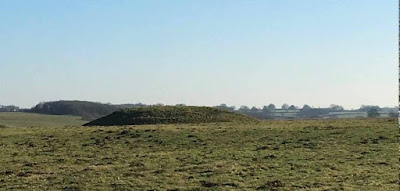Maybe it
started life as a Roman road, or maybe the Romans improved part of the Icknield
Way, an argument perhaps given more credence by the discovery (or re-discovery,
as the locals will tell you) of SeaHenge, a ‘henge’ of wood and stump in the
sands near Holme. Now it’s a long-distance footpath, connecting with others: in
theory I could start at Holme and walk all the way to Lyme Regis.
 |
| Bronze age barrow at Anmer |
It’s provided inspiration for many small bits of my books. At its closest point to the West Norfolk villages where generations of my family are buried, it runs between a series of Bronze Age barrows (more family graves?), two exceptionally well preserved. On this stretch, yellowhammers frequent the hedgerows, singing the song usually written as ‘little-bit-of-bread-and-no-cheese’, but that I hear as ‘see-me-see-me-see-me-please’.
Nearly two thousand years past, the Roman soldiers stationed nearby had come from Pannonia, in the Hungarian plain – where, too, yellowhammers sing their staccato song. Walking along the road, heading perhaps to or from the fort at Brancaster or the signal station near Thornham, they’d have heard the familiar song, a reminder of home. And so yellowhammers feature in my books, singing ‘see-me-see-me-see-me-please’.
The Peddars Way has inspired words from writers other than me: Hugh Lupton, Liz McGowan, and Tom Perkins were the creators of the Norfolk Songline project, beginning with temporary installations but eventually establishing a line of permanent sculptures along the Peddars Way.
Many of the visual images in Empire’s Legacy come from my many walks along the Peddars Way, whether it’s the sea-pies (oystercatchers) and other waders in the saltmarshes, the heat-baked grain harvest, the wide open space and sky my protagonist Lena needs so much. But the most direct transposition of experience to words is in this passage from Empire’s Hostage, based entirely on the barrows near Anmer:
The call of a curlew drifted over the moor, over our small and silent band, over the burial mounds I could now see on either side of the path, mournful, ancient, eternal.
 |
| Buy on Amazon |
 |
| The first in a new series of quick-read, cosy mysteries set in the 1970s. A Mirror Murder https://getbook.at/MirrorMurder |
Eighteen-year-old library assistant Jan Christopher’s life is to change on a rainy Friday evening in July 1971, when her legal guardian and uncle, DCI Toby Christopher, gives her a lift home after work. Driving the car, is her uncle’s new Detective Constable, Laurie Walker – and it is love at first sight for the young couple.
But romance is soon to take a back seat when a baby boy is taken from his pram, a naked man is scaring young ladies in nearby Epping Forest, and an elderly lady is found, brutally murdered...
Are the events related? How will they affect the staff and public of the local library where Jan works – and will a blossoming romance survive a police investigation into murder?
Reviews
“A delightful read about an unexpected murder in North East London.” Richard Ashen (South Chingford Community Library)
“Lots of nostalgic, well-researched, detail about life in the 1970s, which readers of a certain age will lap up; plus some wonderful, and occasionally hilarious, ‘behind the counter’ scenes of working in a public library, which any previous or present-day library assistant will recognise!” Reader Review
and...COMING SOON
A new edition with new additional scenes - launching 21st June - e-book available for pre-order (paperback to follow soon!) https://viewbook.at/WhenMermaidSings





I enjoyed this post -and am delighted because I've wondered for quite a while what bird, in our orchard, was singing "see-me-see-me-see-me-please"! Now I know - thanks Marian!
ReplyDelete